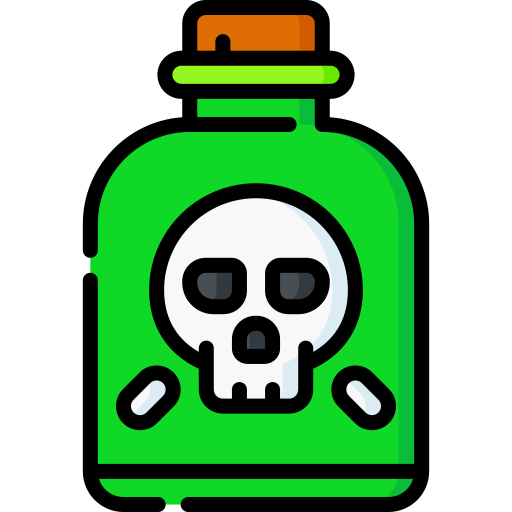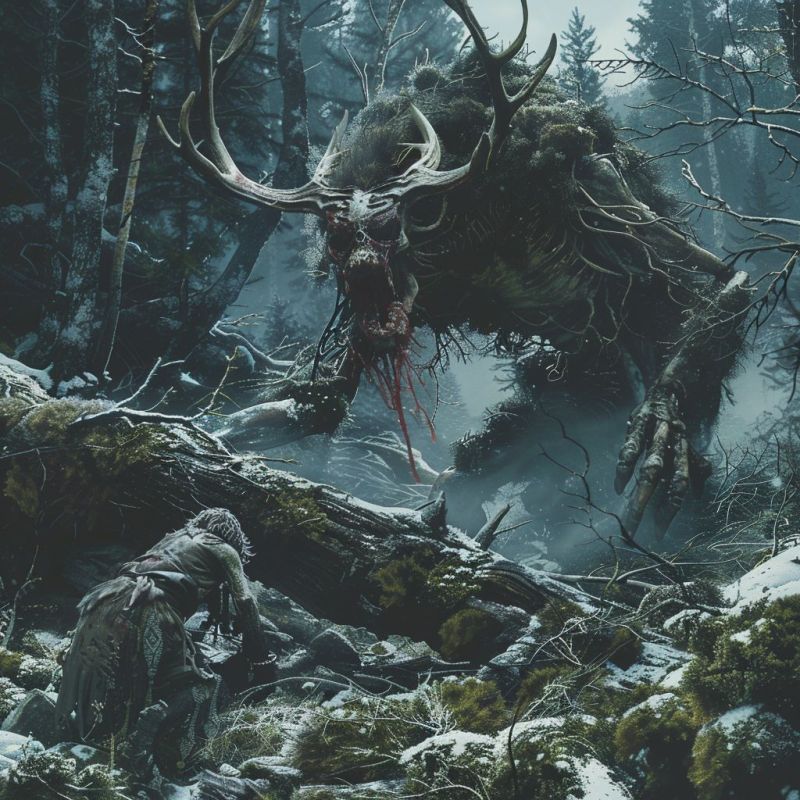 Natural Armor:
Natural Armor:-
Natural Armor +50 gp
 Natural Weapon(s):
Natural Weapon(s):-
Bite (4d12)
-
Claw (2d10)
 Passive Abilities:
Passive Abilities:-
Keen Senses1500 gp
 Full Abilities:
Full Abilities:-
Cry of the Wendigo
-
When the Night Comes
 Abilities:
Abilities:-
Legendary Defenses
 Quick Abilities:
Quick Abilities:-
Uncontrollable Hunger
 Attack Abilities:
Attack Abilities:-
Ensnaring Attack (Claw)100 gp
The gaunt, skeletal figure stands tall, with elongated limbs and claws, its hollow eyes glinting in the moonlight, while its matted fur bristles as it prowls forward, emitting a chilling, inhuman howl.
Origins and Myth
The Wendigo is a fearsome creature born from dark, ancient magic and unspeakable acts. Legends say it was once human, a person who, driven by desperation or madness, resorted to cannibalism in the harshest of winters. This act of consuming human flesh invoked a terrible curse, transforming the individual into a Wendigo—a monstrous being forever tormented by insatiable hunger.
Physical Description
The Wendigo stands tall and emaciated, its skin stretched tightly over bones that seem ready to burst through. Its flesh is pallid, almost translucent, revealing veins that pulse with dark energy. Its eyes are sunken, glowing with an eerie, otherworldly light, and its mouth is filled with sharp, jagged teeth. Claws as long as daggers extend from its fingers, capable of rending flesh from bone with ease.
Domain of Darkness
The Wendigo's presence twists the very fabric of reality. When it cries out, the day turns to night, and warmth is replaced by a bone-chilling cold. This transformation traps its prey within its domain, a twisted reflection of the world filled with illusions and terrors designed to drive them mad. The Wendigo revels in this manipulation, enjoying the fear and despair it evokes.
Uncontrollable Hunger
Central to the Wendigo's existence is its unending hunger. After killing a creature, it consumes both body and soul, restoring its own vitality and perpetuating its cursed existence. This act is not just a necessity but a compulsion, driven by a need that can never be truly sated.
The Cry of Despair
The Wendigo's howl is a sound that reverberates through the soul, shaking reality and filling minds with visions of horror. Those who hear it are often struck by paralyzing fear, their minds assaulted by illusions of their worst nightmares. This cry serves to weaken its prey, making them easier to hunt and devour.
The Curse of the Wendigo
The curse that creates a Wendigo is as ancient as it is unbreakable. Once transformed, the creature is doomed to wander the land, a relentless predator. Its existence is one of eternal suffering, its only solace found in the brief moments of consumption. However, this solace is fleeting, as the hunger always returns, stronger and more demanding than before.
Encounters and Survival
Encountering a Wendigo is a test of will and endurance. Adventurers who find themselves within its domain must steel their minds against its illusions and find ways to combat the bone-chilling cold. Weapons of pure silver are said to be particularly effective against it, as are spells of light and fire that can pierce through the darkness it commands.
Societal Impact
Stories of the Wendigo are used to warn against the dangers of desperation and the loss of humanity. In some cultures, rituals are performed to ward off its presence, and the sighting of a Wendigo is considered an ill omen, often leading to communities taking drastic measures to protect themselves. The fear of becoming a Wendigo has also led to strict taboos against cannibalism, ingrained deeply in societal laws and customs.
Conclusion
The Wendigo is more than a monster; it is a living embodiment of insatiable hunger and eternal torment. Its lore serves as a chilling reminder of the darkness that can lurk within the human soul, and the dire consequences that come from surrendering to that darkness.
Environment:
![]()
😈🌪️ Demons: Abyssal Harbingers of Chaos
Demons are the raw, untamed essence of destruction, spawned in the roiling chaos of the Infinite Layers of the Abyss. 🕳️ These malevolent fiends are the embodiment of anarchy, their monstrous forms barely containing the seething energies of madness and ruin. From the lowliest dretch to the cataclysmic balor, demons surge forth as relentless agents of mayhem, driven by an insatiable urge to corrupt, defile, and annihilate. In any campaign, they are the ultimate force of disorder, their presence a storm that threatens to unravel the fabric of existence itself.
🌑 Unveiling the Abyssal Horrors: Origins of Chaos
Demons are born in the darkest depths of creation, where reality frays into a nightmare of endless turmoil. 🌀 The Abyss, a plane of infinite, ever-shifting layers, is their crucible, each layer a twisted reflection of chaos’s boundless nature. Here, demons emerge not from flesh but from the raw stuff of malevolence, their forms sculpted by the Abyss’s capricious will. They are the antithesis of order, their existence a rebellion against structure, harmony, and life itself, making them harbingers of doom in any world they invade.
Game Masters can root demons in their campaign’s cosmology—perhaps the Abyss is a wound in reality, a god’s shattered dream, or a prison for primal evils. Their origins offer flexibility, allowing demons to serve as cosmic threats, local terrors, or the fallout of a failed ritual.
🧬 Soulforge of the Abyss: Twisted Mortal Spirits
Demons are not born but forged, their essence drawn from mortal souls condemned to the Abyss’s torment. 🖤 These souls, stripped of their humanity, are those who in life embraced chaos—bandits who reveled in lawlessness, tyrants who sowed discord, or dreamers consumed by hateful obsessions. In the Abyss, they are unmade and remade, their spirits warped into nightmarish forms that reflect their sins: a glutton’s soul bloated into a gibbering dretch, a warrior’s rage forged into a hulking hezrou. This transformation severs all ties to their mortal past, leaving only a creature of pure, destructive instinct.
GMs can use this transformation to add depth—perhaps a demon retains a flicker of its mortal life, a vulnerability heroes can exploit, or a campaign hinges on preventing a soul’s descent into demonic rebirth. The process grounds demons in mortal folly, making their horror all the more personal.
🗡️ Wayward Believers: Champions of Anarchy
The souls that become demons were often those who rejected order in life, embracing the freedom of chaos or the power of destruction. 🩸 Some were anarchists who burned cities to ash, others philosophers who saw morality as a cage. Their beliefs, twisted by malice, drew them to the Abyss, where their ideals were distilled into pure malevolence. Even hateful thoughts—envy, wrath, despair—can coalesce into demonic forms, birthed from the collective darkness of mortal minds.
This origin allows GMs to craft demons that mirror their world’s conflicts. A setting plagued by rebellion might spawn demons of defiance, while one steeped in betrayal breeds fiends of deceit. Their mortal roots make them relatable yet alien, a twisted reflection of the campaign’s themes.
🦂 Varieties of Demonic Malevolence: A Legion of Terrors
Demons are as diverse as the chaos they embody, their forms a grotesque gallery of horror. 🕷️ Dretches shuffle as mindless, oozing wretches, while quasits skitter as venomous tricksters. Vrocks swoop with vulture-like savagery, and glabrezu tempt with honeyed lies and crushing claws. At the apex stand balors, towering infernos of rage whose mere presence scorches the earth. Each demon is a unique nightmare, its abilities—claws, venom, psychic screams, or reality-warping magic—reflecting the Abyss’s boundless creativity.
GMs can tailor demons to any encounter, from swarms of lesser fiends overwhelming a village to a single marilith cutting through armies with her bladed dance. Their variety ensures no two demonic threats feel the same, keeping players on edge.
👑 The Infernal Hierarchy: Lords of the Abyss
Amid the Abyss’s chaos, a brutal hierarchy reigns, crowned by the Demon Lords—beings of unfathomable power and cruelty. 🧠 Each lord rules a layer of the Abyss, from Demogorgon’s twin-headed madness to Orcus’s necromantic dominion. These titans command legions of lesser demons, their schemes shaking the multiverse as they war against each other and the forces of good. Their cunning rivals their might, weaving plots that span planes, their influence corrupting mortals and fiends alike.
Game Masters can use Demon Lords as campaign-defining villains, their layers serving as deadly dungeons or their cults as insidious threats. A lord’s presence elevates any story, turning a demonic incursion into an apocalyptic struggle.
⚔️ The Eternal Struggle: Chaos Against Cosmos
Demons are the eternal foes of order and virtue, their existence a relentless assault on the multiverse’s balance. 🌌 They corrupt the pure, shatter the just, and unravel the laws that bind reality. Every demon, from the lowliest manes to the mightiest lord, seeks to drown the world in chaos, their actions a tide that erodes hope and harmony. Heroes who face them are not merely fighting monsters but defending the very fabric of existence, their battles a stand against oblivion.
GMs can frame this struggle to suit their narrative—demons as invaders breaching a holy realm, saboteurs undermining a fragile peace, or tempters luring heroes to ruin. Their opposition to order makes them versatile antagonists, their chaos a catalyst for epic quests.
📜 Unraveling the Abyssal Mystery: Secrets of Demonology
To combat demons, heroes must delve into the forbidden art of demonology, unearthing secrets buried in ancient tomes or whispered by mad seers. 🧙♂️ Scholars seek the Abyss’s vulnerabilities—banishment rituals, wards forged in celestial light, or names that bind demons to obedience. Adventurers hunt relics to sever demonic anchors or lore to weaken a lord’s power. This pursuit is fraught with peril, for the Abyss’s knowledge corrupts as readily as its denizens, tempting the wise with power that leads to damnation.
Game Masters can make demonology a campaign’s heart, with players racing to uncover a lord’s true name or crafting a weapon to slay an unkillable fiend. The mystery ensures demons remain enigmatic, their defeat a triumph of knowledge and courage.
🌑 Engines of Anarchy
Demons are the pulse of chaos, their every act a scream against the ordered world. 😈 In any setting, they adapt—raging through war-torn planes as harbingers of ruin, or slinking through civilized lands as corruptors of the soul. In worlds like Zin, where shadows breed ancient evils, demons might pour from rifts in forgotten depths, their chaos threatening to drown the land in blood. They are the ultimate challenge, their malevolence a fire that tests heroes’ resolve, forcing them to confront not just monsters but the darkness within themselves.
To face a demon is to battle the Abyss itself, a foe that knows no restraint and seeks no mercy. Heroes who triumph may banish a lord or seal a rift, but the Abyss endures, its laughter a promise of chaos yet to come. 🌪️
 Special Senses:
Special Senses:-
 Fiendsight: +60
Fiendsight: +60
 Damage Type Immunity:
Damage Type Immunity:-
 Poison
Poison
 Immune to Status Effect:
Immune to Status Effect:-
 Poisoned
Poisoned
